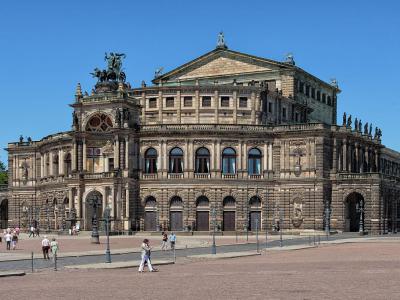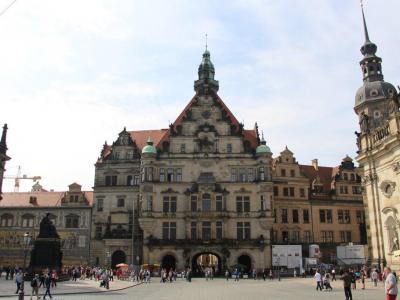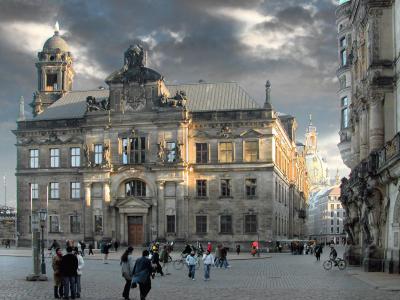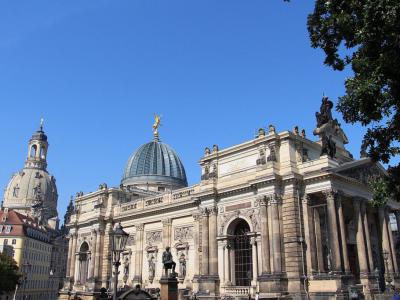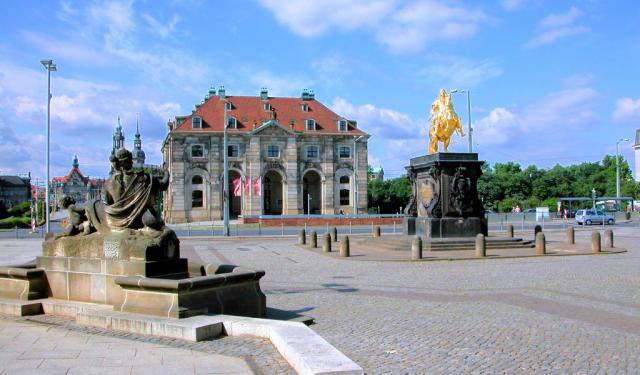
Dresden's Architectural Jewels (Self Guided), Dresden
If there is one thing Dresden is particularly famous for, it is the magnificent architecture. Although known primarily for its Baroque buildings, the city has several other architectural styles present too, such as Renaissance, Historicism, Modernism and Post-modernism.
Much of downtown Dresden was destroyed in February 1945 by Allied bombing, which in turn prompted the rebuilding of the city's classic skyline – especially after the fall of communism, from 1989. Several elements of the Baroque architecture that formed Dresden’s reputation as a first-class architectural destination have been modified, rendering these beauties a true magnet for tourists.
Presently there are almost 13,000 listed cultural monuments in Dresden. Here are some of the most notable of them, from an architectural standpoint:
Katholische Hofkirche – an imposing Catholic church, in service since 1751; apart from being the final resting place for various kings and members of the former Wettin royal family, this cathedral is renowned for its organ, historic High Altar and 18th-century sculptures and allegories;
Stallhof – once a showplace for jousting tournaments, dating back to the 16th century, today it plays host to more sedate events, such as Middle Age Christmas market; the beautifully Italianate features of the Stall Courtyard include Classical pillars and a huge 101-meter external mural sweeping Schlossplatz Square, known as the Procession of Princes;
Frauenkirche (Church of Our Lady) – the most prominent building at the ever-evolving, partially reconstructed Neumarkt. Built in the late 1720s, this church, half-destroyed during World War II, is a symbol of Dresden’s terrible war-time devastation – a memorial for peace, comprising 43 per cent of the original structure, retrieved from the rubble.
To explore in more detail some of the most impressive architectural jewels of Dresden, take this self-guided walking tour.
Much of downtown Dresden was destroyed in February 1945 by Allied bombing, which in turn prompted the rebuilding of the city's classic skyline – especially after the fall of communism, from 1989. Several elements of the Baroque architecture that formed Dresden’s reputation as a first-class architectural destination have been modified, rendering these beauties a true magnet for tourists.
Presently there are almost 13,000 listed cultural monuments in Dresden. Here are some of the most notable of them, from an architectural standpoint:
Katholische Hofkirche – an imposing Catholic church, in service since 1751; apart from being the final resting place for various kings and members of the former Wettin royal family, this cathedral is renowned for its organ, historic High Altar and 18th-century sculptures and allegories;
Stallhof – once a showplace for jousting tournaments, dating back to the 16th century, today it plays host to more sedate events, such as Middle Age Christmas market; the beautifully Italianate features of the Stall Courtyard include Classical pillars and a huge 101-meter external mural sweeping Schlossplatz Square, known as the Procession of Princes;
Frauenkirche (Church of Our Lady) – the most prominent building at the ever-evolving, partially reconstructed Neumarkt. Built in the late 1720s, this church, half-destroyed during World War II, is a symbol of Dresden’s terrible war-time devastation – a memorial for peace, comprising 43 per cent of the original structure, retrieved from the rubble.
To explore in more detail some of the most impressive architectural jewels of Dresden, take this self-guided walking tour.
How it works: Download the app "GPSmyCity: Walks in 1K+ Cities" from Apple App Store or Google Play Store to your mobile phone or tablet. The app turns your mobile device into a personal tour guide and its built-in GPS navigation functions guide you from one tour stop to next. The app works offline, so no data plan is needed when traveling abroad.
Dresden's Architectural Jewels Map
Guide Name: Dresden's Architectural Jewels
Guide Location: Germany » Dresden (See other walking tours in Dresden)
Guide Type: Self-guided Walking Tour (Sightseeing)
# of Attractions: 8
Tour Duration: 1 Hour(s)
Travel Distance: 1.9 Km or 1.2 Miles
Author: vickyc
Sight(s) Featured in This Guide:
Guide Location: Germany » Dresden (See other walking tours in Dresden)
Guide Type: Self-guided Walking Tour (Sightseeing)
# of Attractions: 8
Tour Duration: 1 Hour(s)
Travel Distance: 1.9 Km or 1.2 Miles
Author: vickyc
Sight(s) Featured in This Guide:
- Katholische Hofkirche (Catholic Church)
- Semperoper (Opera House)
- Georgentor (George Gate)
- Sächsisches Ständehaus (Saxon State House)
- Stallhof (Stall Courtyard)
- Dresden Academy of Fine Arts
- Frauenkirche (Church of Our Lady)
- Kreuzkirche (Holy Cross Church)
1) Katholische Hofkirche (Catholic Church) (must see)
Dresden Cathedral is Dresden's most important Catholic church. Architect Gaetano Chiavari designed the Baroque church, which was completed in 1751. It was commissioned by Augustus II, Elector of Saxony and King of Poland. Dresden Cathedral was built at the same time as the Lutheran Church of Our Lady.
Dresden's population was Protestant, but its rulers were Catholic. Augustus II built the church for his own use and connected it to Dresden Castle with a decorative walkway. It was originally known as the Court Church of the Most Holy Trinity. It became a cathedral in 1964.
The cathedral's balustrades feature 78 statues of saints. A procession ambulatory was integrated into the interior because outdoor Catholic worship was forbidden.
The baptismal font features a gilded metal lid and was designed in 1721. In addition, the cathedral has an organ built by famed organist Gottfried Silbermann.
Many of Saxon's rulers are buried in the cathedral's crypts. The Founder's Crypt holds the remains of Polish King Augustus III. King Augustus the Strong is buried here, as is the last King of Saxony.
Dresden Cathedral was damaged during World War II bombing raids and was restored in 1962.
Dresden's population was Protestant, but its rulers were Catholic. Augustus II built the church for his own use and connected it to Dresden Castle with a decorative walkway. It was originally known as the Court Church of the Most Holy Trinity. It became a cathedral in 1964.
The cathedral's balustrades feature 78 statues of saints. A procession ambulatory was integrated into the interior because outdoor Catholic worship was forbidden.
The baptismal font features a gilded metal lid and was designed in 1721. In addition, the cathedral has an organ built by famed organist Gottfried Silbermann.
Many of Saxon's rulers are buried in the cathedral's crypts. The Founder's Crypt holds the remains of Polish King Augustus III. King Augustus the Strong is buried here, as is the last King of Saxony.
Dresden Cathedral was damaged during World War II bombing raids and was restored in 1962.
2) Semperoper (Opera House)
The Opera House (Semperoper) in Dresden is a monumental structure with deep historical and cultural significance. Serving as the home to the Saxon State Opera (Sächsische Staatsoper Dresden), the Saxon State Orchestra (Staatskapelle Dresden), and the Semperoper Ballett, this iconic opera house is not only a venue for world-class performances but also an architectural treasure.
Designed by the renowned architect Gottfried Semper, the Opera House was first constructed in 1841. However, it faced destruction by fire in 1869 and underwent a significant rebuilding process, led once more by Semper. Although Semper was in exile due to political involvement, his son, Manfred Semper, used his father's plans to complete the reconstruction in 1878. This second opera house emerged in the Neo-Renaissance style and exemplified what is known as "Dresden Baroque," marking it as one of the most beautiful opera houses in Europe.
The building displays an eclectic architectural style, combining early Renaissance, Baroque, and Greek classical revival elements, including Corinthian pillars. Located on Theatre Square beside the Elbe River, the Semperoper features a facade decorated with a Panther quadriga and a Dionysos statue. Internally, it showcases works from architects like Johannes Schilling and sculptors such as Ernst Rietschel. Monuments of figures like Goethe, Schiller, and Shakespeare enhance its cultural significance.
The Opera House's history is marked by numerous premieres of significant works by composers like Richard Wagner and Richard Strauss, playing a pivotal role in shaping the musical landscape. Tragically, the opera house was largely destroyed during the bombing of Dresden in World War II in 1945, which left only its external shell.
Reconstruction efforts mirrored the original designs, and the opera house was ceremoniously reopened on February 13, 1985, exactly 40 years after its destruction. The reopening performance featured Carl Maria von Weber's "Der Freischütz," the same opera staged before the building was destroyed in 1945. Today, the Opera House continues to enchant audiences with its historical legacy, architectural beauty, and rich program of operatic and ballet performances.
Designed by the renowned architect Gottfried Semper, the Opera House was first constructed in 1841. However, it faced destruction by fire in 1869 and underwent a significant rebuilding process, led once more by Semper. Although Semper was in exile due to political involvement, his son, Manfred Semper, used his father's plans to complete the reconstruction in 1878. This second opera house emerged in the Neo-Renaissance style and exemplified what is known as "Dresden Baroque," marking it as one of the most beautiful opera houses in Europe.
The building displays an eclectic architectural style, combining early Renaissance, Baroque, and Greek classical revival elements, including Corinthian pillars. Located on Theatre Square beside the Elbe River, the Semperoper features a facade decorated with a Panther quadriga and a Dionysos statue. Internally, it showcases works from architects like Johannes Schilling and sculptors such as Ernst Rietschel. Monuments of figures like Goethe, Schiller, and Shakespeare enhance its cultural significance.
The Opera House's history is marked by numerous premieres of significant works by composers like Richard Wagner and Richard Strauss, playing a pivotal role in shaping the musical landscape. Tragically, the opera house was largely destroyed during the bombing of Dresden in World War II in 1945, which left only its external shell.
Reconstruction efforts mirrored the original designs, and the opera house was ceremoniously reopened on February 13, 1985, exactly 40 years after its destruction. The reopening performance featured Carl Maria von Weber's "Der Freischütz," the same opera staged before the building was destroyed in 1945. Today, the Opera House continues to enchant audiences with its historical legacy, architectural beauty, and rich program of operatic and ballet performances.
3) Georgentor (George Gate)
The George Gate is Dresden's first Renaissance building. George the Bearded commissioned the gate which was built between 1530 and 1535. The George Gate replaced a city gate that provided the original exit from Dresden to the Elbe bridge.
The building's facade features decorate figures with a religious theme. In addition, George the Bearded's motto is inscribed on the facade--"through envy of the devil came death into the world" (in Germany ""Per Invidiam Diaboli Mors Intravit In Orbem").
In 1701, a fire destroyed Dresden castle, and George Gate was renovated to house royal apartments. In 1833, an additional level was added, and in 1868 a ballroom was added.
The facade was redesigned to reflect the Neo-Renaissance style in 1901. Sculptor Christian Behren created an imposing equestrian statue of George the Bearded in George Gate's gable.
Saxony's last king, Friedrich August III, lived in George Gate until 1918. George Gate was destroyed by World War II bombs in 1945 and reconstructed during the 1960s.
George Gate houses several exhibitions. Visitors can see the Coin Cabinet with a collection of ancient medals and coins. In addition, George Gate houses an artwork exhibition.
The building's facade features decorate figures with a religious theme. In addition, George the Bearded's motto is inscribed on the facade--"through envy of the devil came death into the world" (in Germany ""Per Invidiam Diaboli Mors Intravit In Orbem").
In 1701, a fire destroyed Dresden castle, and George Gate was renovated to house royal apartments. In 1833, an additional level was added, and in 1868 a ballroom was added.
The facade was redesigned to reflect the Neo-Renaissance style in 1901. Sculptor Christian Behren created an imposing equestrian statue of George the Bearded in George Gate's gable.
Saxony's last king, Friedrich August III, lived in George Gate until 1918. George Gate was destroyed by World War II bombs in 1945 and reconstructed during the 1960s.
George Gate houses several exhibitions. Visitors can see the Coin Cabinet with a collection of ancient medals and coins. In addition, George Gate houses an artwork exhibition.
4) Sächsisches Ständehaus (Saxon State House)
The Sachsisches Standehaus, otherwise known as the Saxon House of Estates or Saxon State House, is an early 20th century house built by Paul Wallot. Located in Dresden's Old Town, Saxon State House was formerly the parliament building. It now serves as the seat of the Dresden Higher Regional Court and the State Office for the Preservation of Monuments in Saxony.
The original Saxon State House was built on a site once occupied by the Bruhlsche Palace, the Furstenburgsche House and the Charonsche House. These were all demolished to make room for the large palace. It was built with three stories in a trapezoidal shape.
Saxon State House contains an impressive collection of statues and artwork. Most of these works of art were created from 1905 through 1907. Artists who contributed to the Saxon State House include John Schilling, Heinrich Wedemeyer, Heinrich Epler, Ernest Paul, Peter Poeppelmann, Semlar Werner and many others.
The house was badly damaged during the World War II air raids. Reconstruction began almost immediately. However, it was thoroughly renovated between 1996 and 2001. It now holds seven courtrooms and a number of representative rooms for the state parliament.
The original Saxon State House was built on a site once occupied by the Bruhlsche Palace, the Furstenburgsche House and the Charonsche House. These were all demolished to make room for the large palace. It was built with three stories in a trapezoidal shape.
Saxon State House contains an impressive collection of statues and artwork. Most of these works of art were created from 1905 through 1907. Artists who contributed to the Saxon State House include John Schilling, Heinrich Wedemeyer, Heinrich Epler, Ernest Paul, Peter Poeppelmann, Semlar Werner and many others.
The house was badly damaged during the World War II air raids. Reconstruction began almost immediately. However, it was thoroughly renovated between 1996 and 2001. It now holds seven courtrooms and a number of representative rooms for the state parliament.
5) Stallhof (Stall Courtyard)
Stall Courtyard is the stable yard of the residential palace. It was built in 1586 for Christian I from designs by Giovanni Maria Nosseni. It is one of the oldest tournament arenas in the world that has retained its original design.
The stable yard were heavily damaged during the air raids of World War II. Reconstruction began in 1957 but is not yet completed. However, most of the exterior, gallery space and upper floor was restored. The gallery is open to the public as part of the Dresden State Art Collections.
Reconstruction of the Stall Courtyard included the restoration of the Renaissance ceiling, 17th century bronze columns and the 16th century sandstone pool. Thirteen columns are preserved as well. There were originally 34 of these, which were cast by Merten Hilger in 1591. A mural made from 23,000 porcelain tiles on the outer wall of the Stall Courtyard shows the history of the Saxon dynasty.
Stall Courtyard is now used for cultural events, theatrical performances and horse shows.
The stable yard were heavily damaged during the air raids of World War II. Reconstruction began in 1957 but is not yet completed. However, most of the exterior, gallery space and upper floor was restored. The gallery is open to the public as part of the Dresden State Art Collections.
Reconstruction of the Stall Courtyard included the restoration of the Renaissance ceiling, 17th century bronze columns and the 16th century sandstone pool. Thirteen columns are preserved as well. There were originally 34 of these, which were cast by Merten Hilger in 1591. A mural made from 23,000 porcelain tiles on the outer wall of the Stall Courtyard shows the history of the Saxon dynasty.
Stall Courtyard is now used for cultural events, theatrical performances and horse shows.
6) Dresden Academy of Fine Arts
The Dresden Academy of Fine Arts is one of the oldest schools of art in the German speaking world. The academy is significant because it replaced court patronage and provided a platform for learning, interaction and promotion of art and artists in the region.
The Dresden Academy of Fine Arts occupies three buildings and the prominent part of the college is in Bruhl’s terrace near Frauenkirche. The buildings were designed by architect, Constantin Lipsius by the order of Prince Elector Frederick Christian of Saxony and built between 1887 and 1894. The building has a neo renaissance style and the distinctive feature is a large glass dome called the lemon squeezer because of its shape. The structure suffered extensive damage in the 1945 fire bombings. The academy was reorganized, reconstructed and restored to its former glory in 1991.
The Academy of Fine Arts has an illustrious past of being administered by some well known artists of the time. Prominent directors were French artist, Charles Hutin, the first director and Bernardo Bellotto also known as Canaletto who painted landscapes of Dresden City. The Academy became one of the most important fine art schools in Europe in the 19th century because of teachers like painters, Anton Graff and Adrian Zingg.
The Dresden Academy of Fine Arts occupies three buildings and the prominent part of the college is in Bruhl’s terrace near Frauenkirche. The buildings were designed by architect, Constantin Lipsius by the order of Prince Elector Frederick Christian of Saxony and built between 1887 and 1894. The building has a neo renaissance style and the distinctive feature is a large glass dome called the lemon squeezer because of its shape. The structure suffered extensive damage in the 1945 fire bombings. The academy was reorganized, reconstructed and restored to its former glory in 1991.
The Academy of Fine Arts has an illustrious past of being administered by some well known artists of the time. Prominent directors were French artist, Charles Hutin, the first director and Bernardo Bellotto also known as Canaletto who painted landscapes of Dresden City. The Academy became one of the most important fine art schools in Europe in the 19th century because of teachers like painters, Anton Graff and Adrian Zingg.
7) Frauenkirche (Church of Our Lady) (must see)
The current Church of Our Lady is a Lutheran church built between 1726 and 1743. It features Baroque architecture and has one of Europe's largest domes.
The first Church of Our Lady was a Catholic church built in the 11th century. It became a Protestant church during the Reformation. The original church was torn down and replaced by the new Luthern church.
In 1736, Gottfried Silbermann built an exceptional 43-stop organ for the church. Johann Sebastian Bach played a recital on the organ on December 1, 1736.
The church's iconic dome is 96 meters (315 feet) tall. The dome is known as Stone Bell ("die Steinerne Glocke" in German). The dome is often compared to Michelangelo's Saint Peter's Basilica dome. Stone Bell weighed 12,000 tons and was originally held up by eight supports.
In 1945, Allied forces bombed Dresden. The church survived two days of attacks before collapsing. While most of the church was destroyed, the original altar and chancel were salvaged.
Residents salvaged and numbered stone fragments, hoping to use them in a future reconstruction. In 1994, Gunter Blobel won the Nobel Prize for medicine and donated his prize money to restore the Church of Our Lady. In addition, England's Prince Edward supported the Dresden Trust which contributed funds for the reconstruction project.
Rebuilding the Church of Our Lady cost 180 million Euros. The rebuilding effort began in 1992 and was completed in 2005. The church was rebuilt using the original plans from the 1720s and salvaged materials. About 3,800 original stones were used in the reconstruction. One can see the original stones in the building as they appear darker due to age and fire damage.
Rebuilding the church was a community-wide effort. Builders relied on photographs and memories to reconstruct the details. For example, old wedding albums helped builders reconstruct the church's carved oak doors.
A new orb and cross were forged and placed on top of the dome. The original damaged cross stands inside by the church's altar. The original organ was replaced with a 68-stop organ.
The rebuilt Church of Our Lady is a popular attraction. US President Barack Obama visited the church in 2009.
The first Church of Our Lady was a Catholic church built in the 11th century. It became a Protestant church during the Reformation. The original church was torn down and replaced by the new Luthern church.
In 1736, Gottfried Silbermann built an exceptional 43-stop organ for the church. Johann Sebastian Bach played a recital on the organ on December 1, 1736.
The church's iconic dome is 96 meters (315 feet) tall. The dome is known as Stone Bell ("die Steinerne Glocke" in German). The dome is often compared to Michelangelo's Saint Peter's Basilica dome. Stone Bell weighed 12,000 tons and was originally held up by eight supports.
In 1945, Allied forces bombed Dresden. The church survived two days of attacks before collapsing. While most of the church was destroyed, the original altar and chancel were salvaged.
Residents salvaged and numbered stone fragments, hoping to use them in a future reconstruction. In 1994, Gunter Blobel won the Nobel Prize for medicine and donated his prize money to restore the Church of Our Lady. In addition, England's Prince Edward supported the Dresden Trust which contributed funds for the reconstruction project.
Rebuilding the Church of Our Lady cost 180 million Euros. The rebuilding effort began in 1992 and was completed in 2005. The church was rebuilt using the original plans from the 1720s and salvaged materials. About 3,800 original stones were used in the reconstruction. One can see the original stones in the building as they appear darker due to age and fire damage.
Rebuilding the church was a community-wide effort. Builders relied on photographs and memories to reconstruct the details. For example, old wedding albums helped builders reconstruct the church's carved oak doors.
A new orb and cross were forged and placed on top of the dome. The original damaged cross stands inside by the church's altar. The original organ was replaced with a 68-stop organ.
The rebuilt Church of Our Lady is a popular attraction. US President Barack Obama visited the church in 2009.
8) Kreuzkirche (Holy Cross Church)
Located at the center of the Old Town in Dresden near the Altmarkt square, the Kreuzkirche has one of the finest Boy’s Choirs in Europe. The 92 meter high tower has a balcony from which one can see a 36 degree view of the city of Dresden.
A small church stood on the location of the present Kreuzkirche from the early 12th century. In 1388, it was formally dedicated to the Holy Cross. The church burned down and was rebuilt five times. The recent reconstruction was in 1955 after the World War II bombing of the city. Kreuzkirche is the largest church in Saxony. The 13th century church was replaced by a gothic building after a fire. In 1492, the Gothic structure caught fire and was rebuilt. In 1539, the first Lutheran service in Dresden was held in the newly reconstructed church. A tower was added to the church between 1579 and 1584. In 1760, the Prussian army bombarded and damaged the church. Architect, Johann Georg Schmidt designed a new neoclassicist structure and the church opened its doors again in 1792.
The newly rebuilt church in 1955 has a simple interior. The acoustics in the hall are impressive especially when the famous Boy’s Choir performs and on Saturday afternoons when cross choir vespers take place.
A small church stood on the location of the present Kreuzkirche from the early 12th century. In 1388, it was formally dedicated to the Holy Cross. The church burned down and was rebuilt five times. The recent reconstruction was in 1955 after the World War II bombing of the city. Kreuzkirche is the largest church in Saxony. The 13th century church was replaced by a gothic building after a fire. In 1492, the Gothic structure caught fire and was rebuilt. In 1539, the first Lutheran service in Dresden was held in the newly reconstructed church. A tower was added to the church between 1579 and 1584. In 1760, the Prussian army bombarded and damaged the church. Architect, Johann Georg Schmidt designed a new neoclassicist structure and the church opened its doors again in 1792.
The newly rebuilt church in 1955 has a simple interior. The acoustics in the hall are impressive especially when the famous Boy’s Choir performs and on Saturday afternoons when cross choir vespers take place.
Walking Tours in Dresden, Germany
Create Your Own Walk in Dresden
Creating your own self-guided walk in Dresden is easy and fun. Choose the city attractions that you want to see and a walk route map will be created just for you. You can even set your hotel as the start point of the walk.
Dresden New Town Walk
The Neustadt (New Town) of Dresden is a central district located on the north bank of the Elbe. Despite the name, this part of the city is not at all new and has been inhabited for as long as the Old Town on the opposite side of the river. Its “novelty” derives from "Neue Königliche Stadt" (New Royal Town), which is the title given to the area, formerly the district of Altendresden,... view more
Tour Duration: 1 Hour(s)
Travel Distance: 2.2 Km or 1.4 Miles
Tour Duration: 1 Hour(s)
Travel Distance: 2.2 Km or 1.4 Miles
Dresden Introduction Walking Tour
Dresden was likely settled on the banks of the River Elbe by Neolithic tribes as far back as 7,500 BC. But it also has a long and storied history as the long-time capital of Saxony. The Electors and Kings lived here for centuries, appointing the city with every cultural and artistic treasure.
Its modern form--and its name--comes from early Germanic people, who expanded East to mine the Ore... view more
Tour Duration: 2 Hour(s)
Travel Distance: 2.5 Km or 1.6 Miles
Its modern form--and its name--comes from early Germanic people, who expanded East to mine the Ore... view more
Tour Duration: 2 Hour(s)
Travel Distance: 2.5 Km or 1.6 Miles
The Most Popular Cities
/ view all

